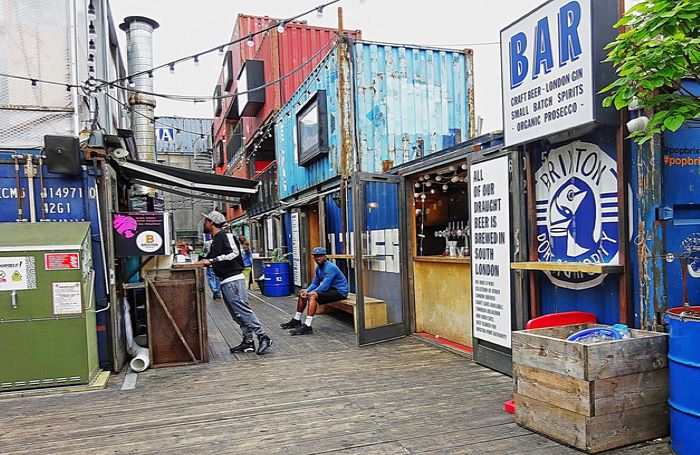Why leave space – a resource so scarce in cities – underused? This is the fundamental premise behind ‘meanwhile uses’, which create activity on a space that would otherwise be empty. But although they seem an obviously good idea – and have support in principle from every level of policymaking – meanwhile uses can be surprisingly difficult to put in place.
Even in prosperous times, cities have vacant spaces. Back in 2018, found that 22,000 commercial units in the capital had been sitting empty for at least six months – and half of these for more than two years. The most visible of them were empty shops, but there were also plenty of underused parking lots, sites awaiting demolition, or new office buildings struggling to find a long-term occupier.
Many more of these spaces appear in a time of crisis. Two years into the 2008 recession, central London’s office vacancy rate reached a high of , and it is likely that the 2020 coronavirus crisis, the associated surge in remote working and online shopping, and the ensuing recession will lead to a similar increase in vacancies.
Yet, giving these spaces over to meanwhile uses or ‘pop-ups’ is not as easy as it sounds. Traditionally landlords, investors and local authorities tend to be risk-averse, preferring to wait for the ‘right’ occupier rather than take a rent cut or experiment with temporary use. But attitudes are changing quickly, and there are ways to ‘make the stars align’ and create successful meanwhile use projects.
This blog post, part of a series published for the Future Place programme, discusses the role of meanwhile use in the wake of the coronavirus pandemic, and explores strategies for integrating unused spaces in town centres and high streets as we look towards the recovery.
Improve match-making
As any temporary occupier of a space will tell you the most difficult part is to get a hold of the keys. Finding out which spaces are empty in your city and who owns them is surprisingly tricky, yet all local authorities should hold this data from collecting business rates. Some London boroughs, such as Brent, have been releasing this data, while others, such as Southwark, have been collating a register of interest from potential occupiers.
These tactics are not resource-intensive and represent simple ways for local authorities to improve matchmaking. Public sector landlords can also lead by example by opening their spaces to meanwhile activity. Cities like Paris have, for example, launched a call for ideas to revitalise some of their derelict holdings. In addition to making spaces available for activity, this is a great way to garner interest and galvanise efforts towards new, innovative uses.

Consider it an investment
If given enough time to recoup set-up costs, interim uses can be profitable – but seeing them through this lens risks missing the point. Interim spaces have something different to offer. Free from the constraint of permanence, they create room for experimentation. Since they are not purpose-built, they are often relatively affordable spaces, which can be given over to uses that would otherwise be priced out of the city.
Landlords, whether public or private, could therefore see meanwhile use as an investment – in communities, in growth companies, in charitable activity. Projects may primarily create social value rather than economic uplift – though both can go hand in hand, as with the example of the Camden Collective, which offers free and subsidised workspace in the heart of Camden; or the Grands Voisins project, which housed refugees in a former Parisian hospital and created opportunities for them to work on the site.
Some developers see meanwhile use as a way to trial new occupations of a space, or boost activity. But meanwhile uses are also a way to open up city-making to groups who would otherwise not be invited to contribute. Where this has happened, it has been for the better: meanwhile uses can be some of the most loved spaces in development projects – the in King’s Cross is a good example of this.
Build trust, and have a move-on strategy
The central question for any successful temporary use is how to create value in the longer term. This is not a given. Through our research, we heard about many instances of occupiers having to leave a site at very short notice – with the site subsequently lying empty for a significant period of time. Much more rarely, though this seems to be a major preoccupation among landlords, have occupiers actively campaigned to remain on site.
Although the majority of projects that we surveyed had gone well, landlords and occupiers alike speak of the virtue of setting out expectations clearly, and of maintaining communication between parties afterwards. Some landlords also help meanwhile spaces find a new location to ensure they can continue to serve their local purpose, while professional meanwhile use operators, such as , have been building up a portfolio of sites that occupiers can move to.

Building back better
Coronavirus has forced us to reevaluate the makeup of our built environment and how we engage with it. As we reemerge from lockdown, much of what we will love about our future places will likely be nurtured or trialled in meanwhile spaces. If managed correctly, these spaces can help us mitigate the economic recession caused by Coronavirus while helping involve residents in the co-creation of places for the local community.
The UK has of good practice to help inspire you. Now is the time to use it as we look to build back better.
About the author
Nicolas Bosetti is Research Manager at the Centre for London where he leads on research projects investigating London’s critical challenges. Nicolas’ research interests include housing, transport, city government, and planning for sustainable growth. He is passionate about making the case for more self-government for regions and cities.



